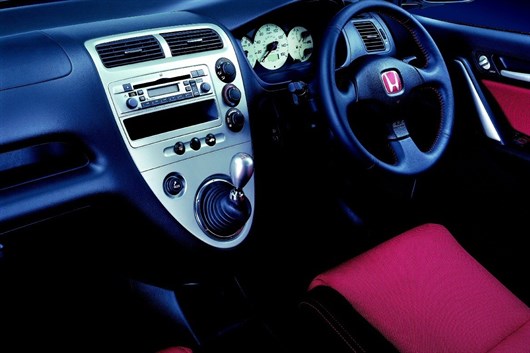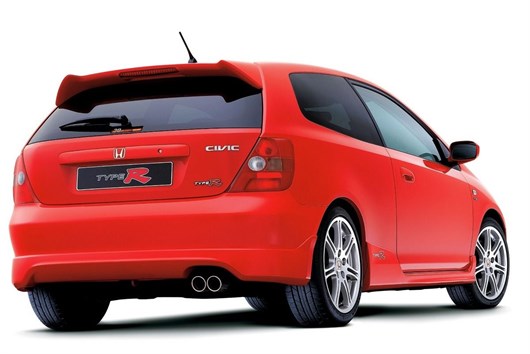Future Classic Friday: Honda Civic Type R

As hot hatchbacks go, the Honda Civic was perhaps one of the least likely candidates to become a bit of a legend.
In standard form, the Civic was a byword for Daily Mail reading Middle England. A safe, reliable, well made small car that was just the ticket for trips to Sainsbury’s, Sunday lunch or the bridge club. It was a car that appealed, primarily, to the more mature motorist, and was quite a success with it, garnering a reputation for being dull but dutiful, and oh, so dependable.
There was nothing mature about the second generation Civic Type R, though. Honda had its first foray into creating a truly hot Civic with the EK9 model – the generation before the one that was such a hit in the UK – but it was its sister car, the Integra Type R, that really got enthusiasts talking. Here was a Honda with screaming acceleration and a thoroughly well sorted chassis. A car that took Honda’s Formula One experience and reputation for complex engineering to a level where it could truly be enjoyed by enthusiasts for a sensible outlay.
After its success in Europe, Honda decided to create a European-spec Type R derivative specifically for Western markets. That car would be based on the Swindon-built EP3 Civic, introduced in 2000, and would be manufactured alongside cooking three door models at the UK plant. Few people were quite prepared for how good it would be.

You could never accuse the Type R's interior of being dull.
When it made its debut in late 2001, the £23,000 Type R wowed the motoring media. It’s normally aspirated VTEC engine, which would only start to come alive at around 5000rpm and would spin all the way to 8000rpm before hitting the rev limiter, made it an absolute joy to drive... or thrash. It would hit 60mph from a standstill in 5.8 seconds, while its dash-mounted six-speed gearshift was supremely slick. Figure hugging Recaro seats and a wonderfully responsive chassis made it one of the best – if not the best – hot hatches of its generation, with perhaps the only criticism being levelled at a lack of feel from the electric power steering.
A 2003 facelift saw the power increase from 200bhp to 215bhp and modifications to the steering weighting, and these later cars are very much the complete package from a driving perspective, although the revised headlights look a bit goofy and the cabin is more fussy, meaning it’s the original model that remains the favourite among enthusiasts.
Now, then, is the time to look at the Type R as a potential classic. With the oldest examples being 16 years old, and with many of them tired and thrashed, a good, unmodified example is something to keep and cherish. Right now, there are plenty around in the classifieds and they start from as little as £2000 for something semi-respectable – though according to experts it’s the body condition that’s most important. The VTEC engines are designed to take a thrashing and hold up well, but the Civic harks from an era where Japanese manufacturers hadn’t quite ironed out the rust problems that had blighted their reputation through the Seventies and Eighties. EP3 Civics can rust, so check the rear suspension mounts and trailing edge of the sills carefully, especially behind the plastic side skirts.
A cherished Type R is definitely a sound investment – and now is the time to buy.

Comments
Compare classic car insurance quotes and buy online. A friendly service offering access to a range of policies and benefits.


 Craig Cheetham
Craig Cheetham
 NEC classic motor show 2020 postponed due to Covid 19 concerns
NEC classic motor show 2020 postponed due to Covid 19 concerns
 Classic car auction house Coys goes into administration
Classic car auction house Coys goes into administration
 Motor racing great Sir Stirling Moss dies aged 90
Motor racing great Sir Stirling Moss dies aged 90
 Alfa Romeo anniversary races set for Silverstone
Alfa Romeo anniversary races set for Silverstone
 Government to make E5 fuel available for classic owners
Government to make E5 fuel available for classic owners
 Plans to introduce cleaner fuel could damage more than a million classic cars
Plans to introduce cleaner fuel could damage more than a million classic cars
 Top 10: Classic cars from the Gulf motor racing heritage collection
Top 10: Classic cars from the Gulf motor racing heritage collection







Matthew Dey on 4 February 2017
It was 16k new or you could pay 1250 for a/C. I know as I bought one.
There was no power increase on any facelift models
The Japanese version had more power though.who made up this article?
Edited by Matthew Dey on 04/02/2017 at 18:43
on 4 February 2017
On point buddy only the white imports had more BHP no other ever did apart from the Ek9 which was 180 or just under at the wheel which I've owned and it's the worst decision I ever made to sellIt .
Add a comment